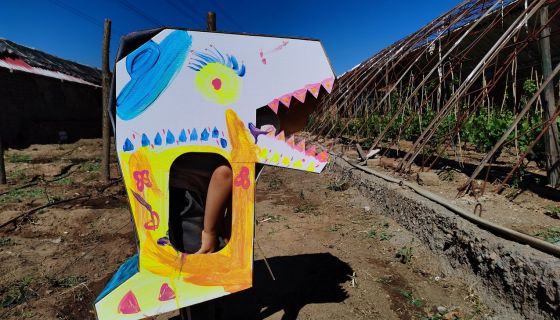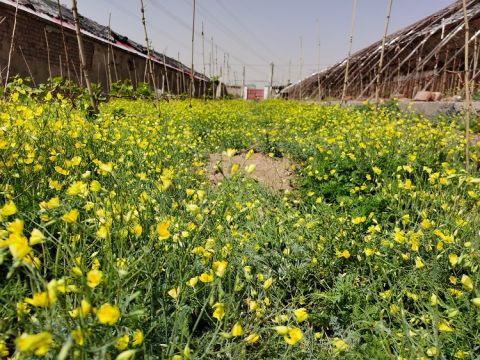After I graduated from Lincoln University in New Zealand, I got stuck between a rock and a hard place. My soul wants to go back to China because we suppose to live close to parents when they get old. However, my body wants to stay in New Zealand as it is the perfect place to pursue my dream to become a winemaker. Compromise is an inevitable part of life, and Finally, I came up with the solution: growing wine in Inner Mongolia.
Then there had to be a family discussion as it was a quite bold move. One person one vote did not work as my son (pictured above) was only 20 months, and he could not have a say. My wife wanted to stay, so we had to draw lots to decide whether to return or to stay. After a few months of zigzagging, we have finally decided to sell our house and packed up the stuff. Somehow, I managed to persuade myself with a very compelling justification: if the quality is equal, a bottle of Pinot Noir grown in Inner Mongolia of China should be more exciting than a bottle of Pinot from Waipara of North Canterbury.
I came back to China with no looking back.
Harsh winter temperature is the primary physical challenge as the lowest temperature in my town often drops below -25℃. I had read literature when I was studying at Lincoln University. I learnt there are two means to solve this problem. One way is surviving the winter by physical protection such as burying the vine with earth or covering the vine with geotextile. Another way is culturing cold-hardy varieties. The first method sounds too industrial and not sustainable as it would consume substantial energy for just producing the hedonistic beverage.
The latter method sounds more attractive to me as I learnt there is a specie called Vitis amurensis, which is originally from China, and it could withstand -45℃. Its defect is the extremely high acidity. For example, Beibinghong is a hybrid cultivar between V. amurensis and V. vinifera. A study of phenolic and chromatic properties of Beibinghong red ice wine was carried out with the following parameters: TA: 13.35g/L; pH: 3.19; Brix:28.9. If the data was correctly harvested, the pH and TA for an ice wine show its extremely high acidity.
The pastoral appeal with a romantic fantasy of vineyards is the primary mental challenge as the marketing campaign rhetoric has also brainwashed me. My dream vineyard will be on a gentle slope which is facing the ocean. It will be surrounded by woods and be stretched to the horizon. Blue sky, white cloud, and green vines, what a paradise.
It turned out that I am not living in my dream world. I searched many places, and finally, I managed to lease a piece of land which sizes about 1000m2. It has a green-house so theoretically I do not have to bury the vines in winter. The greenhouse film is removable, which is only used to protect the vine from extreme winter temperature. Although it is sitting on a gentle slope, it is not facing the ocean but a giant transmission tower. It is so small that I could only squeeze 500 vines in there as the useful planting areas is only about 600m2. I planted some of the v. vinifera on a 'two-layer' VSP to maximise the laying bud number. The first layer of fruiting wire is close to the ground so it could grow into a 1.2metre tall canopy. Then the second layer of fruiting wire sits on top of the bottom canopy. The problem is the top layer`s canopy could eventually grow too high that only Yaoming could do the pruning.
What do I do to farm sustainably? (although I have a different view about sustainability) Everything I do is sustainable as with this size, everything can be done with hands, and I am not hesitated to embrace organic practices. I did not spray anything apart from one application of sulphur last year. All weeds are removed by hands, and soils are worked by a spade. Maybe it sounds a bit superstitious, but I always talk to the vines, and I consider them as my 500 mates. My parents have intercropped cucumbers, spring onions, capsicums, tomatoes, and corns in any possible gaps in the vineyard. They do not comprehend the meaning of my wine-growing project, which seems unrealistic and unfeasible to them, but their intercropped veggie garden is practical and realistic. It produces so many organic vegetables that we always give away the veggies to family relatives and friends.
My short-term plan is to commercialise this tiny vineyard by producing around 1000 bottles of wine to prove my 12-year-old nephew is wrong, who told me that 'dream will not buy bread!'. I also would like to show people who do not believe in the story of David and Goliath that great wine does not only come from conglomerates with intensive capital or aristocratic families with many generations of winemakers. In the 21st century, people should have the encouragement and the inspiration to be whatever they want to be (in the legal limits though), should not be daunted by the barriers of capitals, technologies, and hierarchies.
The long-term plan is to change the world for sure. We all have been told to make a better world ever since we were small. But we had been misguided that such change must be accomplished via great revolutions or exporting universal values. Perhaps, we can make a better world by starting with small things, and without a loud voice, just like the fermentation which transforms the must completely, but quietly.
Grapevine could change the world.
It harvests the sunlight and turns it into carbohydrates. It is a perennial plant so its permanent roots could be utilised for mitigating soil erosions. It can use infertile slopes which are unsuitable for grain production.
Let`s change the world with grapevines, and starting with 500 of them.















